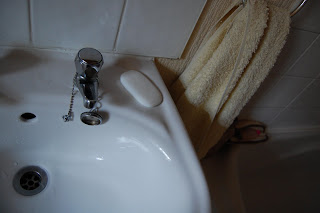

The monumental, hanger-like spaces that create the Tramway are an attraction in themselves. The pregnant potential of the surviving tramline sunk into a lake of concrete, preserved to a point where it seems almost operational, in the religiously vast space of the Tramway 2 gallery, contrast impressively. This duet sets the scene for the contribution of the Italian sculptor Lara Favaretto.
Upright, wall mounted car wash brushes are rotating, stopping, pausing and restarting along the walls. The low murmurs of mechanisms soundtrack the exhibits; a process is unfolding, carefully programmed. Mesmerised yet curious one proceeds, aware that this performance is not for us, but would continue without our engagement. Coupled together in clusters of different sizes, with an array of vibrant and muted colours, they are personified through the titles; 'Kelly and Griff', 'Maria and Felix' and 'Thing', the orange lone ranger in the corner. Although embroiled with these personas their kinetics are contained, staged to a point that renders them caged and waiting for more intense observation.
Instantly accessible through mere spectacle alone, greater attention is nothing but rewarding. The iron plates which the brushes are rotating against are also slowly disintegrating the plastic of the bristles. Action simultaneously leaves it perishable. This melancholy of the eventual failure of the objects is reiterated by the three 'confetti cubes' sharing the Tramway space. These blocks slip into your consciousness at a slower pace, a quiet contribution waiting patiently on the floor for your discovery. Such a throw-away material like confetti compressed into this solid form jars expectations, however the flurry of visitors to the gallery has facilitated the beginnings of a return to the material’s more common incarnation; scattered and un-sculpted. The semi-crumbling cubes are live relics, so playfully fragile they almost invite destruction.
It is easy to imagine works becoming a scratch on the surface of the largest Tramway gallery space. But fortunately Favaretto triumphs in pastel and paint box hues, as she transforms the space into a ball room of contemporary proportions. Enjoyable, but not to be underestimated, this installation takes a mundane starting point and elevates it beyond every stretch of the imagination.

She has in the past suspended a Gypsy caravan from a crane, constructed a machine for showering viewers with confetti and created an installation in which visitors were invited to sit beneath a felt-clad tree that responded by shedding its autumn leaves.












































